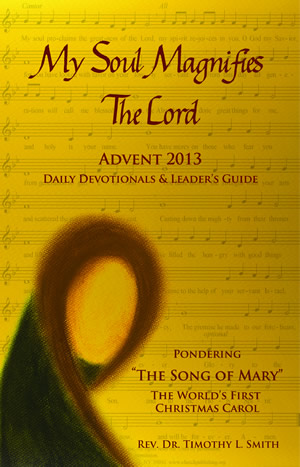
Luke 1:46-55
INTRODUCTION
Mary the mother of Jesus has inspired more people than any other woman who has ever lived. She has been portrayed in more art and more music than any other woman in history. In this the prophecy of Scripture stands true: from generation to generation, people will call Mary “Blessed”.
But Mary is also remarkable for having written and sung the world’s first, and perhaps greatest Christmas carol. It is Mary’s Song, or, Magnificat, that is the focus of this 25-day devotional for Advent 2013. We know from Scripture that Mary was a person who thought deeply and pondered the meaning of things. In this daily devotional we will follow Mary’s lead and ponder the significance of Jesus for us, and for the world.
Churches and individuals tend to rush to the night of Jesus’ birth, overlooking the momentous days building up to it. But we will go back to explore the angel Gabriel’s astonishing announcement to Mary, look at her willing consent to do God’s will, and reflect on her inspired praise song to God. After all, who better to interpret the meaning of Jesus and His birth than Jesus’ mother! It was Mary who was there from the beginning, carrying Jesus, bearing Him, nursing Him, and protecting Him. She is the only person to stand with Jesus at His cradle and at His cross. No one on earth has ever known Jesus, or loved Jesus, quite like His mother. She is the first person to call Him “Savior” or to follow after Him. Filled with the Holy Spirit Mary bursts into song and graces us with this great hymn of praise. Her song can lead us into a more profound grasp of God’s grace and greater love for God’s Son who comes to us as a baby.
Overview of this Devotional
This daily devotional takes in the four weeks of Advent and Christmas Day. In the First Week of Advent we will explore Gabriel’s announcement to Mary about Messiah’s coming, and see how Mary said, “Yes!” to God’s will. In the Second through Fourth Weeks of Advent we will reflect line by line on the words of Mary’s Song. Each day’s reading will conclude with opportunity for pondering the personal significance of Mary’s words. There will be emphasis upon following Mary’s example as one who reflected on Scripture, and through the lens of Scripture interpreted the things happening to her.
At the end of this devotional you will find a Leader’s Guide to assist in facilitating small groups in engaging Mary’s Song. People often relate how much more they gain from reflecting on God’s Word together. Perhaps you would like to use this devotional and Leader’s Guide in your Sunday school class, Advent group, home Bible study, or neighborhood fellowship.
WHO IS MARY?
Her English name “Mary” comes from the Latin “Maria” which is derived from her given Hebrew name “Miriam”. In our first Scriptural encounter with Mary she is living with her parents in Nazareth, an obscure, insignificant village in Lower Galilee. We know from recent archeological excavations of Mary’s first century Nazareth that it was home to 300-400 people living in close quarters on a mere four acres. The people of Nazareth are from the peasant class living in grinding poverty, eking out a bare existence through farming, shepherding, and small ventures like village carpentry. The Gospels portray Mary as a member of the anawim (Hebrew): the underclass, the marginalized, and poor.
Little Nazareth is a mere speck on the map, preoccupied with survival and trying to pay the three-fold tax to Rome, King Herod the Great, and the Temple leaders in Jerusalem. The rest of the country mocks little Nazareth, asking: “Can anything good come out of Nazareth?” (John 1:46)
In Mary’s time of the Early Roman Period, there are no paved roads, no public buildings, no marble mosaics or frescoes, and no luxury items of any kind in Nazareth. Archeologists discovered camouflaged caves from the period where villagers would hide from Roman soldiers seeking to flush out Jewish rebels. Life is precarious for villagers caught in the crosscurrents of increasing political turmoil.
Like others in the village Mary lives in an extended family compound, where three or four houses, each of one or two rooms, cluster around an open courtyard. In the courtyard relatives share an oven, a cistern, and a millstone for grinding wheat, sorghum, and flax. Mary likely works 10-12 hours a day on family chores like hauling water, gathering firewood, cooking meals, washing utensils and clothes, and caring for their few animals.
Mary lives in a multi-lingual world, hearing Latin from the soldiers, Greek spoken by traveling merchants, Hebrew in the prayers and readings of home and synagogue, and Aramaic spoken with a distinct Galilean accent. Mary probably has the dark hair and dark eyes like the Jewish and Palestinian women in the Holy Land today.
Mary’s humble life in insignificant Nazareth gives little hint of her noble lineage (Luke 1:32,69; Psalm 132:11). Mary’s parents, along with Roman census takers in Bethlehem, may be the only ones who know Mary is descended from King David. Mary is also related to Elizabeth, the wife of Zechariah the priest, who herself was a descendent of Aaron, Israel’s first high priest (Luke 1:5, 36).
More light may be added to our knowledge about Mary by an early document from A. D. 145, called Infancy Gospel of James. This writing reports that Mary was born to aged parents, Joachim and Anna (Hebrew: Hannah), long past the time they had given up hope of having children. Like Hannah in the Old Testament who dedicated her son Samuel to the Lord’s service, so Mary was dedicated in the Temple by her parents for life-long service to God.
This same early document also reports that when Mary was twelve years old she was betrothed to Joseph. This would have been in keeping with the Jewish customs of the day that regarded girls ready for marriage at twelve years and six months, and married around thirteen.
As the Gospel story begins to unfold before us, Mary is young, female, and poor, just the sort of things that disqualify her in the eyes of her village to ever do anything great for God. Add to that the fact that Mary is unmarried, and soon to be pregnant, and she sits precariously in her insecure little world. And yet, all of this is preparing us to ponder God’s amazing grace working through ordinary people like you and me.


